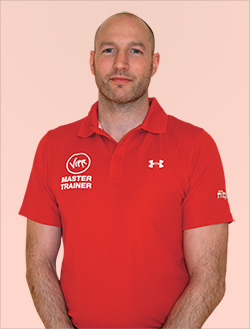A day in the life of a master ViPR trainer
Dave Parker has been a master ViPR trainer for 12 months. In that time, he has delivered the one-day ViPR Training Certificate to personal trainers in UK health and fitness clubs, and attended fitness expos to demonstrate the benefits of ViPR. Here is a typical day in his life as a master ViPR trainer.
 Usually it’s an early start on the road to the designated venue, as the journey by car or rail can vary from one to four hours. The ViPR course starts at 09:30 and I always arrive at the venue before the students turn up, as this creates a good, professional impression. It also allows me to check out the venue and take care of any logistical issues.
Usually it’s an early start on the road to the designated venue, as the journey by car or rail can vary from one to four hours. The ViPR course starts at 09:30 and I always arrive at the venue before the students turn up, as this creates a good, professional impression. It also allows me to check out the venue and take care of any logistical issues.
If it’s been a while since my last workshop, I like to prepare by familiarizing myself with course lesson plans and content. If you don’t use it, you lose it! There is set content to deliver, which ensures consistency and quality of delivery and stops trainers going off on a tangent for any great length of time.
When students start to arrive, I make sure I meet and greet them individually, getting a feel for their experience of ViPR. It’s normally a mixed bag, with some being very experienced and others completely new to it. I can then pitch the day’s course material at the correct level.
The number of students varies, ranging from 15 to 30. It’s important to know student numbers beforehand and also how many ViPR tools there will be at the course venue. I have a number of ViPR tools myself and, when travelling by car, I make sure they’re in the trunk just in case I need them. Obviously, the more students, the more organization is needed, and it can be very challenging to get all content and feedback in before the end of the course.
The one-day ViPR Certificate aims to teach students how to use ViPR safely and effectively, and also how to program ViPR exercises at the right level for clients. What draws me to ViPR is its versatility, enabling it to be used with a large cross-section of individuals (from beginners to experts) and uses (from endurance to strength) and also recovery-of-function programs following a diagnosed soft-tissue injury. I also like the fact that students get to flip, drag, lift and shift in all manner of directions during the day and have fun doing it. It’s just as good to use inside as it is outside in a park.
The workshop is highly practical and all students participate in the course content. I encourage each student to explore the possibilities of using ViPR during exercise. Each student is asked to demonstrate regression and progression of a number of key exercises. The first one or two exercises require me to assist students with their feedback; however, it doesn’t take long for students to get the idea and their creativity and confidence starts to flow. By the end of the day, all will leave the course knowing how to perform over 100 different variations of 12 basic exercises.
Safety is important and, as exercising with ViPR requires a degree of skill, students must learn how to perform each exercise with good technique – but this doesn’t always happen at first. Like any new skill, there are certain stages of learning before there is consistency of performance. What I’ve noticed though (and not just with students but with my own clients) is that fatigue quickly sets in to the body and it is the hip muscles that tire first, particularly in beginners. Using ViPR is whole-body training, all of the time. The hips are important for whole-body function and good technique. The result of hip fatigue is normally rounding in the back. A larger flexion response means more low-back stress and potential to injure oneself. However, seeing this provides good evidence to the students that technique is paramount all of the time. They know they must stop and recover or drop to regression. I reinforce this many times throughout the day. Despite this serious message, the day is fun and light-hearted and it’s great to see each student increasing their understanding of ViPR.
By the end of the day, students are normally all exercised out – brains as well as bodies are on shut down. It’s a physically and mentally draining day, but there are still the final practical assessments to go. After assessments, its feedback, course evaluation and where to go to keep up to date with ViPR news and exercises before everyone goes home. Most students are now skilled in using ViPR; however, I encourage students to keep learning and increase their knowledge in human movement science, as this will make ViPR an even more powerful and relevant tool to use with clients.
To view more ViPR content then click here to register – it’s absolutely free